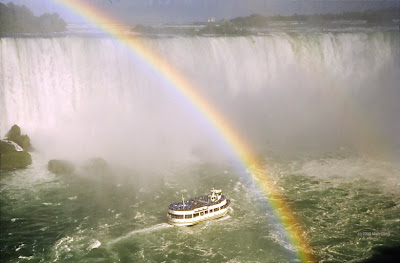From the Wikipedia entry “Slowly I Turned“:
The routine has two performers pretending to meet for the first time, with one of them becoming highly agitated over the utterance of particular words. Names and cities (such as Niagara Falls) have been used as the trigger, which then send the unbalanced person into a state of mania; the implication is that the words have an unpleasant association in the character’s past. While the other performer merely acts bewildered, the crazed actor relives the incident, uttering the words, “Slowly I turned…step by step…inch by inch…,” as he approaches the stunned onlooker. Reacting as if this stranger is the object of his rage, the angry actor begins hitting or strangling him, until the screams of the victim shake him out of his delusion. The actor then apologizes, admitting his irrational reaction to the mention of those certain words. This follows with the victim innocently repeating the words, sparking the insane reaction all over again. This pattern is repeated in various forms, sometimes with the entrance of a third actor, uninformed as to the situation. This third person predictably ends up mentioning the words and setting off the manic performer, but with the twist that the second actor, not this new third person, is still the recipient of the violence.
I spent about five years, between my late-teens and early twenties, working in photo labs. It was the easiest thing for me to do, seeing as I had a natural disposition toward photography. I spent many hundreds and hundreds (I suppose I could just write “thousands”, but then that seems like such an exaggeration) of hours printing other people’s photographs, correcting the colour, correcting the density – even occasionally eliminating hairs or scratches on the negatives. All said, it was a thankless job, but not a job one does in the first place if one is seeking thanks.
It was while I held this position that I read (or heard – I am convinced the toxic chemicals eroded my memories from those days) that the most photographed place on the earth was not the pyramids of Egypt, not the Great Wall of China, nor was it the Grand Canyon.
It was Niagara Falls, Canada.
And you know what? That person was absolutely right, from my perspective at least. I have seen so many photographs of Niagara Falls, from so many angles, from so many different types of cameras, lenses, and film stocks that when Ingrid and I went there during the summer, it felt as if I were entering some sort of nightmare/dream world. I hadn’t seen the Falls since I was a kid (with the exception of seeing them from the American side once – not impressive at all) and yet I was intimately familiar with every inch of it. It is the closest thing to recreating deja vu that one can do, I suppose.
 Needless to say, I took photos. What else are you going to do? It’s a giant, massively awe-inspiring natural waterfall. And when I got my slides back, I looked at them and groaned – it didn’t matter how good they were, how picture-postcard they were. I’d seen them all before. From every angle, every camera, every lens, and every film stock.
Needless to say, I took photos. What else are you going to do? It’s a giant, massively awe-inspiring natural waterfall. And when I got my slides back, I looked at them and groaned – it didn’t matter how good they were, how picture-postcard they were. I’d seen them all before. From every angle, every camera, every lens, and every film stock.
I eventually found one photo which wasn’t so eerily pre-reminiscent: a stranger on an observation deck, staring out (not down) philosophically, as if Camus were alive and in Niagara Falls no less. It is through this photo that I found it possible to combat the madness of my previous occupation: to find the angle no one else has bothered to capture. I do not consider it an exceptional photograph from a technical point of view, but for personal reasons it is a healthy way to re-pave my perception of a subject so totally saturated by the second-hand experience of first-hand observation.



